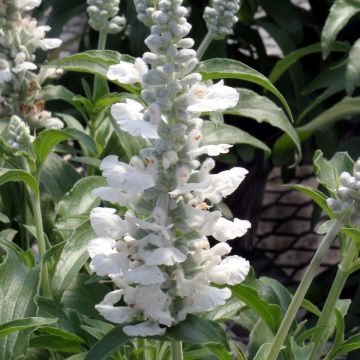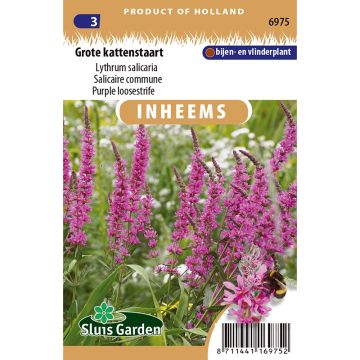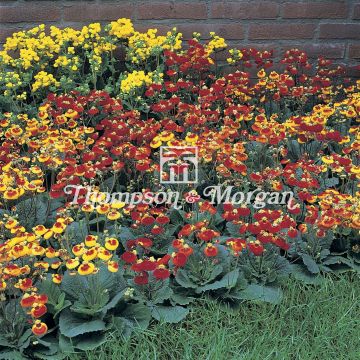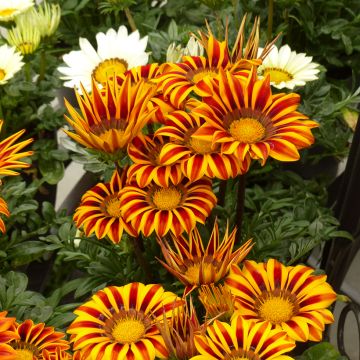

Salvia nemorosa Dwarf Blue Queen Seeds - Wood Sage


Salvia nemorosa Dwarf Blue Queen Seeds - Wood Sage


Salvia nemorosa Dwarf Blue Queen Seeds - Wood Sage
Salvia nemorosa Dwarf Blue Queen Seeds - Wood Sage
Salvia nemorosa Dwarf Blue Queen
Wood Sage, Balkan Clary, Meadow Sage
This item cannot be shipped to the selected country
Dispatch by letter from €3.90
More information
Schedule delivery date,
and select date in basket
This plant carries a 6 months recovery warranty
More information
We guarantee the quality of our plants for a full growing cycle, and will replace at our expense any plant that fails to recover under normal climatic and planting conditions.
Seed-only orders are dispatched by sealed envelope. The delivery charge for seed-only orders is €3.90.
Does this plant fit my garden?
Set up your Plantfit profile →
Description
The Salvia nemorosa 'Dwarf Blue Queen', known as Wood Sage or Forest Sage, is a dwarf form of this upright and well-branched perennial that stands out for its elegant and airy spikes of inflorescences. These spikes, in a very deep blue-violet, bloom throughout the summer, adding a touch of vibrant colour to the garden. This compact and bushy perennial is also valued for its semi-evergreen lanceolate foliage. Very hardy and easy to grow in full sun in well-drained soil, it establishes quickly from the first year, forming a beautiful cover for slightly wild areas of the garden. In addition to beautifying the space, it provides a valuable source of nectar for bees, promoting biodiversity.
The Salvia nemorosa, also known as Salvia superba or Salvia sylvestris, is a plant species of the Lamiaceae family. This perennial herbaceous plant is native to Central Europe and Western Asia. 'Dwarf Blue Queen' is one of its many cultivars; its adult size will not exceed 40 cm in all directions. This perennial has a bushy, very branched, and compact habit. Flowering occurs from June to August, in terminal clusters composed of numerous small flowers (0.5 to 1 cm) in dark blue with reddish-brown bracts. This mix of shades produces a deep blue-violet effect. The beautiful nectar-rich flower spikes succeed each other throughout the summer and delight butterflies. The leaves, 5 to 10 cm long, are ovate or lanceolate, oblong, notched, and puckered. The base of the stems is often reddish.
Plant 'Dwarf Blue Queen' Sage in ordinary, even poor and rather calcareous, but above all well-draining soil. This plant tolerates some drought. It does not appreciate heavy and waterlogged soils in winter that can harm its hardiness. Plant it in a sunny or semi-shaded location. It has the advantage of remaining compact, even in soil that is a bit too rich for it. It looks superb when paired with pale yellow flowering plants like Anthemis ‘Wargrave’ for a strong contrast, or with grey foliage of artemisias and pink flowering plants among the bush roses, for example. Also, associate it with other salvias like clary sage and common sage. It also pairs perfectly with catmints, agastaches, and Lychnis coronaria.
With over 900 species of annuals, perennials, and soft-wooded shrubs distributed worldwide, except in very cold regions and tropical forests, the Salvia genus is the richest in the Lamiaceae family.
Report an error about the product description
Salvia nemorosa Dwarf Blue Queen Seeds - Wood Sage in pictures
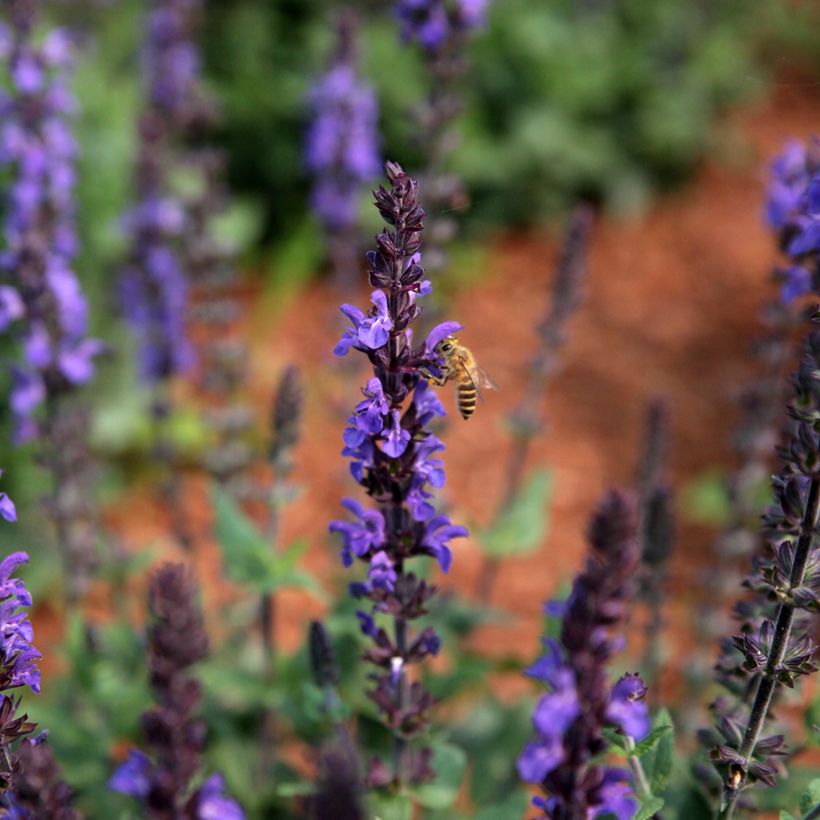



Flowering
Foliage
Plant habit
Botanical data
Salvia
nemorosa
Dwarf Blue Queen
Lamiaceae
Wood Sage, Balkan Clary, Meadow Sage
Salvia x superba Dwarf Blue Queen, Salvia x sylvestris Dwarf Blue Queen
Cultivar or hybrid
Other Salvia seeds
Planting and care
Sow from February to May.
If you cannot provide your sowing with a temperature of at least 15°C, wait until March. Germination may be slow if the temperature is not high enough. A range of 18 to 24°C seems to be ideal. Sow indoors 8 to 10 weeks before the last frost. Do not cover the seeds, as light is necessary for germination.
Transplant the plants if necessary. For best results, opt for a larger pot, increasing the size according to the plant's growth. Move the young plants outdoors at the end of May or beginning of June. Gradually acclimate them to outdoor conditions for 10 to 15 days before transplanting them to their final location. Space them 15 to 30 cm apart. Pinch the tip of the main shoot when the plants reach 15 cm in height to promote bushy growth.
Cultivation:
Grow Salvia Dwarf Blue Queen in ordinary, even poor and rather chalky soil, but above all well-drained. This plant tolerates some drought once well established. It does not appreciate very clayey, sticky, and waterlogged soils in winter that can harm its hardiness. Plant it in a sunny location or at least in partial shade in hot climates. It is an easy plant, very floriferous. In spring, give it fertiliser and in April, shorten all branches by half. After flowering, cut back faded flower stalks to stimulate and prolong flowering. To preserve the vitality of the sage, it is good to divide the plant after 3 or 4 years. Plant it in well-worked and lightened soil: to improve soil that is a bit too poor, mix in some potting compost.
Sowing period
Intended location
This item has not been reviewed yet - be the first to leave a review about it.
Flower seeds
Haven't found what you were looking for?
Hardiness is the lowest winter temperature a plant can endure without suffering serious damage or even dying. However, hardiness is affected by location (a sheltered area, such as a patio), protection (winter cover) and soil type (hardiness is improved by well-drained soil).

Photo Sharing Terms & Conditions
In order to encourage gardeners to interact and share their experiences, Promesse de fleurs offers various media enabling content to be uploaded onto its Site - in particular via the ‘Photo sharing’ module.
The User agrees to refrain from:
- Posting any content that is illegal, prejudicial, insulting, racist, inciteful to hatred, revisionist, contrary to public decency, that infringes on privacy or on the privacy rights of third parties, in particular the publicity rights of persons and goods, intellectual property rights, or the right to privacy.
- Submitting content on behalf of a third party;
- Impersonate the identity of a third party and/or publish any personal information about a third party;
In general, the User undertakes to refrain from any unethical behaviour.
All Content (in particular text, comments, files, images, photos, videos, creative works, etc.), which may be subject to property or intellectual property rights, image or other private rights, shall remain the property of the User, subject to the limited rights granted by the terms of the licence granted by Promesse de fleurs as stated below. Users are at liberty to publish or not to publish such Content on the Site, notably via the ‘Photo Sharing’ facility, and accept that this Content shall be made public and freely accessible, notably on the Internet.
Users further acknowledge, undertake to have ,and guarantee that they hold all necessary rights and permissions to publish such material on the Site, in particular with regard to the legislation in force pertaining to any privacy, property, intellectual property, image, or contractual rights, or rights of any other nature. By publishing such Content on the Site, Users acknowledge accepting full liability as publishers of the Content within the meaning of the law, and grant Promesse de fleurs, free of charge, an inclusive, worldwide licence for the said Content for the entire duration of its publication, including all reproduction, representation, up/downloading, displaying, performing, transmission, and storage rights.
Users also grant permission for their name to be linked to the Content and accept that this link may not always be made available.
By engaging in posting material, Users consent to their Content becoming automatically accessible on the Internet, in particular on other sites and/or blogs and/or web pages of the Promesse de fleurs site, including in particular social pages and the Promesse de fleurs catalogue.
Users may secure the removal of entrusted content free of charge by issuing a simple request via our contact form.
The flowering period indicated on our website applies to countries and regions located in USDA zone 8 (France, the United Kingdom, Ireland, the Netherlands, etc.)
It will vary according to where you live:
- In zones 9 to 10 (Italy, Spain, Greece, etc.), flowering will occur about 2 to 4 weeks earlier.
- In zones 6 to 7 (Germany, Poland, Slovenia, and lower mountainous regions), flowering will be delayed by 2 to 3 weeks.
- In zone 5 (Central Europe, Scandinavia), blooming will be delayed by 3 to 5 weeks.
In temperate climates, pruning of spring-flowering shrubs (forsythia, spireas, etc.) should be done just after flowering.
Pruning of summer-flowering shrubs (Indian Lilac, Perovskia, etc.) can be done in winter or spring.
In cold regions as well as with frost-sensitive plants, avoid pruning too early when severe frosts may still occur.
The planting period indicated on our website applies to countries and regions located in USDA zone 8 (France, United Kingdom, Ireland, Netherlands).
It will vary according to where you live:
- In Mediterranean zones (Marseille, Madrid, Milan, etc.), autumn and winter are the best planting periods.
- In continental zones (Strasbourg, Munich, Vienna, etc.), delay planting by 2 to 3 weeks in spring and bring it forward by 2 to 4 weeks in autumn.
- In mountainous regions (the Alps, Pyrenees, Carpathians, etc.), it is best to plant in late spring (May-June) or late summer (August-September).
The harvesting period indicated on our website applies to countries and regions in USDA zone 8 (France, England, Ireland, the Netherlands).
In colder areas (Scandinavia, Poland, Austria...) fruit and vegetable harvests are likely to be delayed by 3-4 weeks.
In warmer areas (Italy, Spain, Greece, etc.), harvesting will probably take place earlier, depending on weather conditions.
The sowing periods indicated on our website apply to countries and regions within USDA Zone 8 (France, UK, Ireland, Netherlands).
In colder areas (Scandinavia, Poland, Austria...), delay any outdoor sowing by 3-4 weeks, or sow under glass.
In warmer climes (Italy, Spain, Greece, etc.), bring outdoor sowing forward by a few weeks.






































